Induced Plant Accumulation of Lithium
Abstract
:1. Introduction
2. Materials and Methods
2.1. Reagents
2.2. Germination Trials
2.3. Soil Preparation
2.4. Plant Trials
2.5. Sample Preparation and Analysis
2.6. Data Analysis
3. Discussion and Results
3.1. Germination Trials
3.2. Plant Pot Trials
3.3. Trial 1, Li Amended Soil
3.4. Trial 2, Li Amended Soil, EDTA Treatment
3.5. Trial 3, Li Amended Soil, EDDS Treatment
4. Conclusions
Acknowledgments
Author Contributions
Conflicts of Interest
References
- Chaney, R.L. Plant uptake of inorganic waste constituents. In Land Treatment of Hazardous Wastes; Parr, J.F., Marsh, P.B., Kla, J.M., Eds.; Noyes Data Corp.: Park Ridge, NJ, USA, 1983; pp. 50–76. [Google Scholar]
- Sheoran, V.; Sheoran, A.S.; Poonia, P. Agromining: A review. Miner. Eng. 2009, 22, 1007–1019. [Google Scholar] [CrossRef]
- Van Der Ent, A.; Baker, A.J.; Reeves, R.D.; Chaney, R.L.; Anderson, C.W.; Meech, J.A.; Erskine, P.D.; Simonnot, M.O.; Vaughan, J.; Morel, J.L.; et al. Agromining: Farming for metals in the future? Environ. Sci. Technol. 2009, 49, 4773–4780. [Google Scholar] [CrossRef] [PubMed]
- Garbisu, C.; Alkorta, I. Phytoextraction: A cost-effective plant-based technology for the removal of metals from the environment. Bioresour. Technol. 2009, 77, 229–236. [Google Scholar] [CrossRef]
- Brooks, R.R.; Robinson, B.H. The potential use of hyperaccumulators and other plants for agromining. In Plants that Hyperaccumulate Heavy Metals: Their Role in Archaeology, Microbiology, Mineral Exploration, Agromining and Phytoremediation; CAB International: Wallingford, UK, 1998; pp. 327–356. [Google Scholar]
- Robinson, B.H.; Anderson, C.W.N.; Dickinson, N.M. Phytoextraction: Where’s the action? J. Geochem. Explor. 2015, 151, 34–40. [Google Scholar] [CrossRef]
- Sheoran, V.; Sheoran, A.S.; Poonia, P. Agromining of gold: A review. J. Geochem. Explor. 2013, 128, 42–50. [Google Scholar] [CrossRef]
- Robinson, B. Agromining: Growing a crop of metal. Biologist 1999, 46, 201–205. [Google Scholar]
- Phytoremediation and Agromining in Manitoba: Preliminary Observation from an Orientation Survey at the Central Manitoba (Au) Minesite (NTS 52L/13). Report of Activities. Available online: http://manitoba.ca/iem/geo/field/roa00pdfs/00gs-28.pdf (accessed on 5 February 2018).
- Timofeeva, S.S.; Ulrikh, D.V.; Timofeev, S.S. Agromining Perspectives in Rehabilitation of Mining and Industrial Areas of South Ural; InIOP Conference Series. Earth Environ. Sci. 2017, 66, 012030. [Google Scholar]
- Reeves, R.D.; Baker, A.J. Metal accumulating plants. In Phytoremediation of Toxic Metals Using Plants to Clean Up the Environment; Raskin, I., Ensley, B.D., Eds.; John Wiley & Sons Inc.: New York, NY, USA, 2000. [Google Scholar]
- Sachs, J. Manual of Experimental Physiology of Plants. Investigations on the General Living Conditions of the Plants and the Functions of Their Organs; Wilhelm Engelmann: Leipzig, Germany, 1865; p. 514. [Google Scholar]
- Assunção, A.G.; Schat, H.; Aarts, M.G. Thlaspi caerulescens, an attractive model species to study heavy metal hyperaccumulation in plants. New Phytol. 2003, 159, 351–360. [Google Scholar] [CrossRef]
- Brooks, R.R.; Chambers, M.F.; Nicks, L.J.; Robinson, B.H. Agromining. Trends Plant Sci. 1998, 3, 359–362. [Google Scholar] [CrossRef]
- Verbruggen, N.; Hermans, C.; Schat, H. Molecular mechanisms of metal hyperaccumulation in plants. New Phytol. 2009, 181, 759–776. [Google Scholar] [CrossRef] [PubMed]
- Jaffré, T.; Brooks, R.R.; Lee, J.; Reeves, R.D. Sebertia acuminata: A hyperaccumulator of nickel from New Caledonia. Science 1976, 193, 579–580. [Google Scholar] [CrossRef] [PubMed]
- Baker, A.J.M.; McGrath, S.P.; Sidoli, C.M.D.; Reeves, R.D. The possibility of in situ heavy metal decontamination of polluted soils using crops of metal-accumulating plants. Resour. Conserv. Recycl. 1994, 11, 41–49. [Google Scholar] [CrossRef]
- Pollard, A.J.; Reeves, R.D.; Baker, A.J. Facultative hyperaccumulation of heavy metals and metalloids. Plant Sci. 2014, 217, 8–17. [Google Scholar] [CrossRef] [PubMed]
- Rascio, N.; Navari-Izzo, F. Heavy metal hyperaccumulating plants: How and why do they do it? And what makes them so interesting? Plant Sci. 2011, 180, 169–181. [Google Scholar] [CrossRef] [PubMed]
- Sarma, H. Metal hyperaccumulation in plants: A review focusing on phytoremediation technology. J. Environ. Sci. Technol. 2011, 4, 118–138. [Google Scholar] [CrossRef]
- Baker, A.J.M.; Reeves, R.D.; Hajar, A.S.M. Heavy metal accumulation and tolerance in British populations of the metallophyte Thlaspi caerulescens J. & C. Presl (Brassicaceae). New Phytol. 1994, 127, 61–68. [Google Scholar]
- Wang, H.B.; Wong, M.H.; Lan, C.Y.; Baker, A.J.M.; Qin, Y.R.; Shu, W.S.; Chen, G.Z.; Ye, Z.H. Uptake and accumulation of arsenic by 11 Pteris taxa from southern China. Environ. Pollut. 2007, 145, 225–233. [Google Scholar] [CrossRef] [PubMed]
- Dodson, J.R.; Hunt, A.J.; Parker, H.L.; Yang, Y.; Clark, J.H. Elemental sustainability: Towards the total recovery of scarce metals. Chem. Eng. Process. Process Intensif. 2012, 51, 69–78. [Google Scholar] [CrossRef]
- Morrison, R.S.; Brooks, R.R.; Reeves, R.D.; Malaisse, F. Copper and cobalt uptake by metallophytes from Zaïre. Plant Soil 1979, 53, 535–539. [Google Scholar] [CrossRef]
- Blaylock, M.J.; Salt, D.E.; Dushenkov, S.; Zakharova, O.; Gussman, C.; Kapulnik, Y.; Ensley, B.D.; Raskin, I. Enhanced accumulation of Pb in Indian mustard by soil-applied chelating agents. Environ. Sci. Technol. 1997, 31, 860–865. [Google Scholar] [CrossRef]
- Freeman, J.L.; Zhang, L.H.; Marcus, M.A.; Fakra, S.; McGrath, S.P.; Pilon-Smits, E.A. Spatial imaging, speciation, and quantification of selenium in the hyperaccumulator plants Astragalus bisulcatus and Stanleya pinnata. Plant Physiol. 2006, 142, 124–134. [Google Scholar] [CrossRef] [PubMed]
- Anderson, C.W.N.; Brooks, R.R.; Chiarucci, A.; Lacoste, C.J.; Leblanc, M.; Robinson, B.H.; Simcock, R.; Stewart, R.B. Agromining for nickel, thallium and gold. J. Geochem. Explor. 1999, 67, 407–415. [Google Scholar] [CrossRef]
- Huang, J.W.; Blaylock, M.J.; Kapulnik, Y.; Ensley, B.D. Phytoremediation of uranium-contaminated soils: Role of organic acids in triggering uranium hyperaccumulation in plants. Environ. Sci. Technol. 1998, 32, 2004–2008. [Google Scholar] [CrossRef]
- Elektorowicz, M.; Keropian, Z. Lithium, Vanadium and Chromium Uptake Ability of Brassica juncea from Lithium Mine Tailings. Int. J. Phytoremediat. 2015, 17, 521–528. [Google Scholar] [CrossRef] [PubMed]
- Tang, Y.T.; Qiu, R.L.; Zeng, X.W.; Ying, R.R.; Yu, F.M.; Zhou, X.Y. Lead, zinc, cadmium hyperaccumulation and growth stimulation in Arabis paniculata Franch. Environ. Exp. Bot. 2009, 66, 126–134. [Google Scholar] [CrossRef]
- Ernst, W.H. Evolution of metal tolerance in higher plants. For. Snow Landsc. Res. 2006, 80, 251–274. [Google Scholar]
- Krämer, U. Metal hyperaccumulation in plants. Annu. Rev. Plant Biol. 2010, 61, 517–534. [Google Scholar] [CrossRef] [PubMed]
- Salt, D.E.; Blaylock, M.; Kumar, N.P.; Dushenkov, V.; Ensley, B.D.; Chet, I.; Raskin, I. Phytoremediation: A novel strategy for the removal of toxic metals from the environment using plants. Nat. Biotechnol. 1995, 13, 468–474. [Google Scholar] [CrossRef]
- Norvell, W.A. Comparison of chelating agents as extractants for metals in diverse soil materials. Soil Sci. Soc. Am. J. 1984, 48, 1285–1292. [Google Scholar] [CrossRef]
- Nowack, B.; Schulin, R.; Robinson, B.H. Critical assessment of chelant-enhanced metal phytoextraction. Environ. Sci. Technol. 2006, 40, 5225–5232. [Google Scholar] [CrossRef] [PubMed]
- Peters, R.W. Chelant extraction of heavy metals from contaminated soils. J. Hazard. Mater. 1999, 66, 151–210. [Google Scholar] [CrossRef]
- Kołodyńska, D. Chelating agents of a new generation as an alternative to conventional chelators for heavy metal ions removal from different waste waters. In Expanding Iszzsues in Desalination; InTech: Rijeka, Croatia, 2011. [Google Scholar] [CrossRef]
- Nörtemann, B. Biodegradation of Chelating Agents: EDTA, DTPA, PDTA, NTA, and EDDS. In Biogeochemistry of Chelating Agents; Nowack, B., VanBriesen, J.M., Eds.; American Chemical Society: Washington, DC, USA, 2005. [Google Scholar]
- Satroutdinov, A.D.; Chistyakova, T.I.; Dedyukhina, E.G.; Minkevich, I.G. Microbial degradation of EDTA: New EDTA-degrading bacterial strains. In Biogeochemistry of Chelating Agents; American Chemical Society: Washington, DC, USA, 2005; pp. 171–182. [Google Scholar]
- Nowack, B. Environmental chemistry of aminopolycarboxylate chelating agents. Environ. Sci. Technol. 2002, 36, 4009–4016. [Google Scholar] [CrossRef] [PubMed]
- Bucheli-Witschel, M.; Egli, T. Environmental fate and microbial degradation of aminopolycarboxylic acids. FEMS Microbiol. Rev. 2001, 25, 69–106. [Google Scholar] [CrossRef] [PubMed]
- Van Herwijnen, R.; van Fleuren, R.H.L.J. Environmental Risk Limits for EDTA. National Environmental Quality Standards for Substances Netherlands; Report 601782028/2009; RIVM: Bilthoven, The Netherlands, 2009. [Google Scholar]
- Tandy, S.; Bossart, K.; Mueller, R.; Ritschel, J.; Hauser, L.; Schulin, R.; Nowack, B. Extraction of heavy metals from soils using biodegradable chelating agents. Environ. Sci. Technol. 2004, 38, 937–944. [Google Scholar] [CrossRef] [PubMed]
- Schowanek, D.; Feijtel, T.C.; Perkins, C.M.; Hartman, F.A.; Federle, T.W.; Larson, R.J. Biodegradation of [S, S], [R, R] and mixed stereoisomers of ethylenediaminedisuccinic acid (EDDS), a transition metal chelator. Chemosphere 1997, 34, 2375–2391. [Google Scholar] [CrossRef]
- Hyvönen, H. Studies on Metal Complex Formation of Environmentally Friendly Aminopolycarboxylate Chelating Agents. Ph.D. Thesis, University of Helsinki, Helsinki, Finland, 2008. [Google Scholar]
- Takahashi, R.; Fujimoto, N.; Suzuki, M.; Endo, T. Biodegradabilities of ethylenediamine-N, N′-disuccinic acid (EDDS) and other chelating agents. Biosci. Biotechnol. Biochem. 1997, 61, 1957–1959. [Google Scholar] [CrossRef] [PubMed]
- Meers, E.; Tack, F.M.G.; Verloo, M.G. Degradability of ethylenediaminedisuccinic acid (EDDS) in metal contaminated soils: Implications for its use soil remediation. Chemosphere 2008, 70, 358–363. [Google Scholar] [CrossRef] [PubMed]
- Metsärinne, S.; Tuhkanen, T.; Aksela, R. Photodegradation of ethylenediaminetetraacetic acid (EDTA) and ethylenediamine disuccinic acid (EDDS) within natural UV radiation range. Chemosphere 2001, 45, 949–955. [Google Scholar] [CrossRef]
- Turan, M.; Esringu, A. Phytoremediation based on canola (Brassica napus L.) and Indian mustard (Brassica juncea L.) planted on spiked soil by aliquot amount of Cd, Cu, Pb, and Zn. Plant Soil Environ. 2007, 53, 7. [Google Scholar]
- Kos, B.; Greman, H.; Lestan, D. Phytoextraction of lead, zinc and cadmium from soil by selected plants. Plant Soil Environ. 2003, 49, 548–553. [Google Scholar]
- Pereira, B.F.F.; Abreu, C.A.D.; Herpin, U.; Abreu, M.F.D.; Berton, R.S. Phytoremediation of lead by jack beans on a Rhodic Hapludox amended with EDTA. Sci. Agricola 2010, 67, 308–318. [Google Scholar] [CrossRef]
- Seth, C.S.; Misra, V.; Singh, R.R.; Zolla, L. EDTA-enhanced lead phytoremediation in sunflower (Helianthus annuus L.) hydroponic culture. Plant Soil 2011, 347, 231. [Google Scholar] [CrossRef]
- Pinto, I.S.; Neto, I.F.; Soares, H.M. Biodegradable chelating agents for industrial, domestic, and agricultural applications, a review. Environ. Sci. Pollut. Res. 2014, 21, 11893–11906. [Google Scholar] [CrossRef] [PubMed]
- Luo, C.; Shen, Z.; Li, X. Enhanced phytoextraction of Cu, Pb, Zn and Cd with EDTA and EDDS. Chemosphere 2005, 59, 1–11. [Google Scholar] [CrossRef] [PubMed]
- Tandy, S.; Schulin, R.; Nowack, B. Uptake of metals during chelant-assisted phytoextraction with EDDS related to the solubilized metal concentration. Environ. Sci. Technol. 2006, 40, 2753–2758. [Google Scholar] [CrossRef] [PubMed]
- Hauser, L.; Tandy, S.; Schulin, R.; Nowack, B. Column extraction of heavy metals from soils using the biodegradable chelating agent EDDS. Environ. Sci. Technol. 2005, 39, 6819–6824. [Google Scholar] [CrossRef] [PubMed]
- Grčman, H.; Vodnik, D.; Velikonja-Bolta, Š.; Leštan, D. Ethylenediaminedissuccinate as a new chelate for environmentally safe enhanced lead phytoextraction. J. Environ. Qual. 2003, 32, 500–506. [Google Scholar] [CrossRef] [PubMed]
- Fine, P.; Paresh, R.; Beriozkin, A.; Hass, A. Chelant-enhanced heavy metal uptake by Eucalyptus trees under controlled deficit irrigation. Sci. Total Environ. 2014, 493, 995–1005. [Google Scholar] [CrossRef] [PubMed]
- Shilev, S.; Naydenov, M.; Tahsin, N.; Sancho, E.D.; Benlloch, M.; Vancheva, V.; Sapundjieva, K.; Kuzmanova, J. Effect of easily biodegradable amendments on heavy metal solubilization and accumulation in technical crops—A field trial. J. Environ. Eng. Landsc. Manag. 2007, 15, 237–242. [Google Scholar]
- Cao, A.; Carucci, A.; Lai, T.; La Colla, P.; Tamburini, E. Effect of biodegradable chelating agents on heavy metals phytoextraction with Mirabilis jalapa and on its associated bacteria. Eur. J. Soil Biol. 2007, 43, 200–206. [Google Scholar] [CrossRef]
- Lenntech. Lithium (Li) and Water: Reaction Mechanisms, Environmental Impact and Health Effects. 2017. Available online: https://www.lenntech.com/periodic/elements/li.htm (accessed on 2 November 2017).
- Schrauzer, G.N. Lithium: Occurrence, dietary intakes, nutritional essentiality. J. Am. Coll. Nutr. 2002, 21, 14–21. [Google Scholar] [CrossRef] [PubMed]
- Wallace, A.; Romney, E.M.; Cha, J.W.; Chaudhry, F.M. Lithium toxicity in plants. Commun. Soil Sci. Plant Anal. 1977, 8, 773–780. [Google Scholar] [CrossRef]
- Kabata-Pendias, A.; Pendias, H. Source Trace Elements in Soil and Plants, 3rd ed.; CRC Press: Boca Raton, FL, USA, 1984; p. 116. [Google Scholar]
- Shahzad, B.; Tanveer, M.; Hassan, W.; Shah, A.N.; Anjum, S.A.; Cheema, S.A.; Ali, I. Lithium toxicity in plants: Reasons, mechanisms and remediation possibilities—A review. Plant Physiol. Biochem. 2016, 107, 104–115. [Google Scholar] [CrossRef] [PubMed]
- Ammari, T.G.; Al-Zu’bi, Y.; Abu-Baker, S.; Dababneh, B.; Tahboub, A. The occurrence of lithium in the environment of the Jordan Valley and its transfer into the food chain. Environ. Geochem. Health 2011, 33, 427–437. [Google Scholar] [CrossRef] [PubMed]
- Aral, H.; Vecchio-Sadus, A. Toxicity of lithium to humans and the environment—A literature review. Ecotoxicol. Environ. Saf. 2008, 70, 349–356. [Google Scholar] [CrossRef] [PubMed]
- Magalhaes, J.R.; Wilcox, G.E.; Rocha, A.N.F.; Silva, F.L.I.M. Research on lithium-phytological metabolism and recovery of hypo-lithium. Pesqui. Agrospecu. Bras. 1990, 25, 1781–1787. [Google Scholar]
- Kent, N.L. Absorption, translocation and ultimate fate of lithium in the wheat plant. New Phytol. 1994, 40, 291–298. [Google Scholar] [CrossRef]
- Hawrylak-Nowak, B.; Kalinowska, M.; Szymańska, M. A study on selected physiological parameters of plants grown under lithium supplementation. Biol. Trace Elem. Res. 2012, 149, 425–430. [Google Scholar] [CrossRef] [PubMed]
- McStay, N.G.; Rogers, H.H.; Anderson, C.E. Effects of lithium on Phaseolus vulgaris L. Sci. Total Environ. 1980, 16, 185–191. [Google Scholar] [CrossRef]
- Bingham, F.T.; Page, A.L.; Bradford, G.R. Tolerance of plants to lithium. Soil Sci. 1964, 98, 4–8. [Google Scholar] [CrossRef]
- Li, X.; Gao, P.; Gjetvaj, B.; Westcott, N.; Gruber, M.Y. Analysis of the metabolome and transcriptome of Brassica carinata seedlings after lithium chloride exposure. Plant Sci. 2009, 177, 68–80. [Google Scholar] [CrossRef]
- Cannon, H.L.; Harms, T.F.; Hamilton, J.C. Lithium in Unconsolidated Sediments and Plants of the Basin and Range Province, Southern California and Nevada 1975, (No. 918); United States Government Printing Office: Washington, DC, USA, 1975.
- Jiang, L.; Wang, L.; Mu, S.Y.; Tian, C.Y. Apocynum venetum: A newly found lithium accumulator. Flora Morphol. Distrib. Funct. Ecol. Plants 2014, 209, 285–289. [Google Scholar] [CrossRef]
- Tölgyesi, G. Distribution of lithium in Hungarian soils and plants. Lithium 1983, 4, 39–44. [Google Scholar]
- Saeidnia, S.; Abdollahi, M. Concerns on the growing use of lithium: The pros and cons. Iran. Red Crescent Med. J. 2013, 15, 629–632. [Google Scholar] [CrossRef] [PubMed]
- Anderson, C.E. Lithium in Plants. In Lithium and Cell Physiology; Springer: New York, NY, USA, 1990; pp. 25–46. [Google Scholar]
- Schwertfeger, D.M.; Hendershot, W.H. Spike/leach procedure to prepare soil samples for trace metal ecotoxicity testing: Method development using copper. Commun. Soil Sci. Plant Anal. 2013, 44, 1570–1587. [Google Scholar] [CrossRef]
- Wuana, R.A.; Okieimen, F.E.; Imborvungu, J.A. Removal of heavy metals from a contaminated soil using organic chelating acids. Int. J. Environ. Sci. Technol. 2010, 7, 485–496. [Google Scholar] [CrossRef]
- Strange, E.E. Determination of Lithium in Magnesium Alloy by Flame Photometer. Anal. Chem. 1953, 25, 650–651. [Google Scholar] [CrossRef]
- Robinson, B.; Fernández, J.E.; Madejón, P.; Marañón, T.; Murillo, J.M.; Green, S.; Clothier, B. Phytoextraction: An assessment of biogeochemical and economic viability. Plant Soil 2003, 249, 117–125. [Google Scholar] [CrossRef]
- Keeling, S.M.; Stewart, R.B.; Anderson, C.W.N.; Robinson, B.H. Nickel and cobalt phytoextraction by the hyperaccumulator Berkheya coddii: Implications for polymetallic agromining and phytoremediation. Int. J. Phytoremediat. 2003, 5, 235–244. [Google Scholar] [CrossRef] [PubMed]
- Bani, A.; Echevarria, G.; Sulçe, S.; Morel, J.L. Improving the agronomy of Alyssum murale for extensive agromining: A five-year field study. Int. J. Phytoremediat. 2015, 17, 117–127. [Google Scholar] [CrossRef] [PubMed]
- Metallary. Lithium Price. 2017. Available online: https://www.metalary.com/lithium-price (accessed on 7 November 2017).
- Van Der Ent, A.; Baker, A.J.; Reeves, R.D.; Pollard, A.J.; Schat, H. Hyperaccumulators of metal and metalloid trace elements: Facts and fiction. Plant Soil 2013, 362, 319–334. [Google Scholar] [CrossRef]
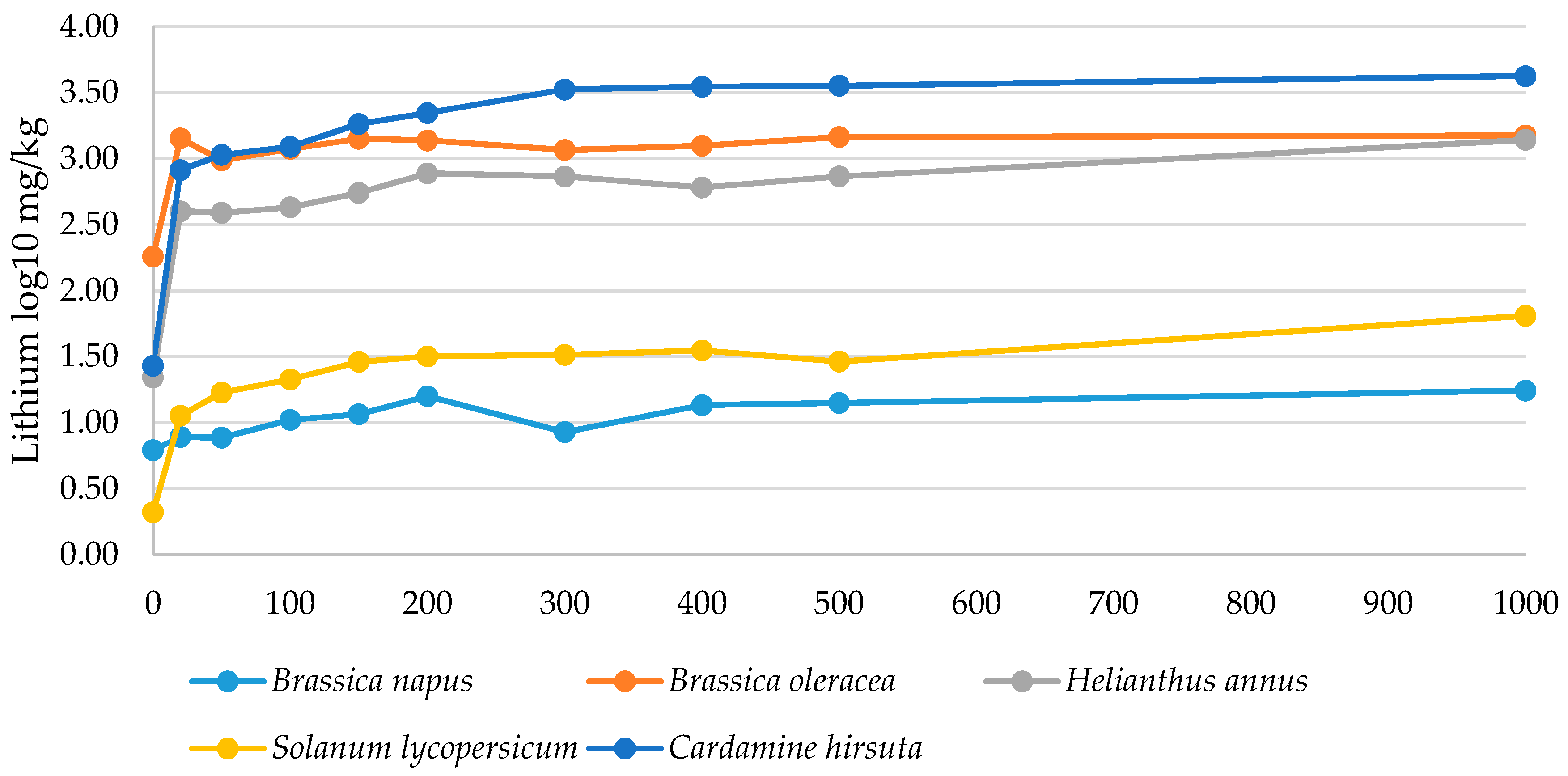
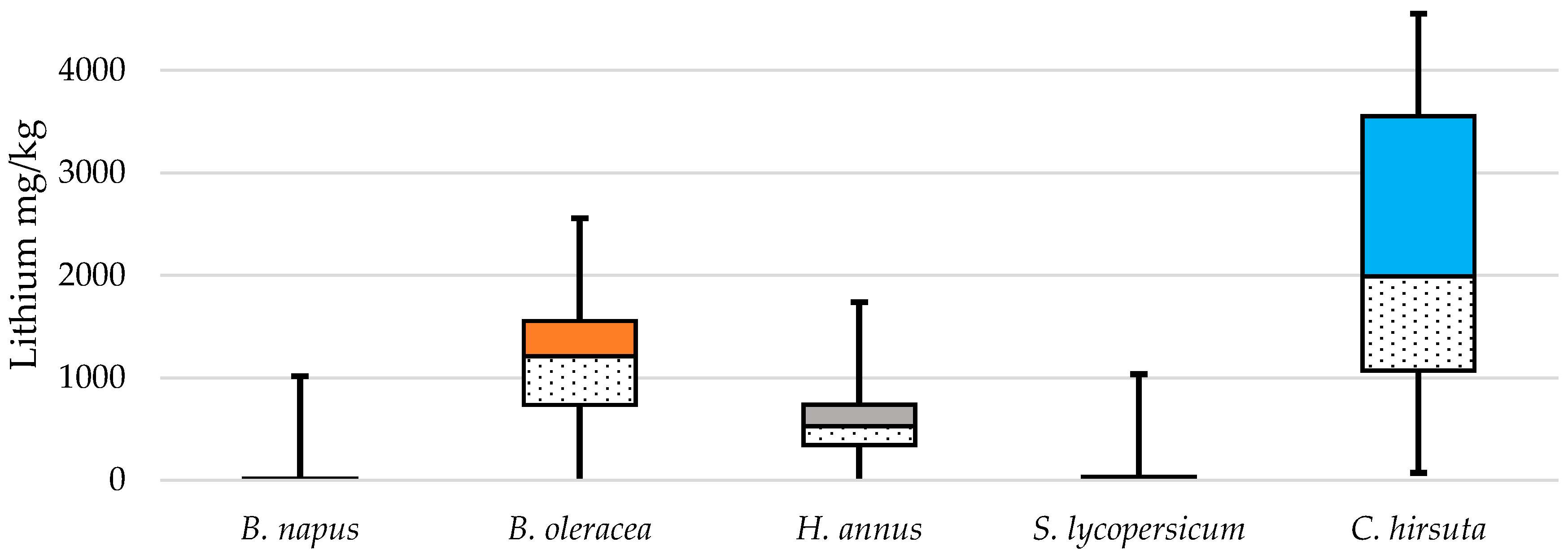
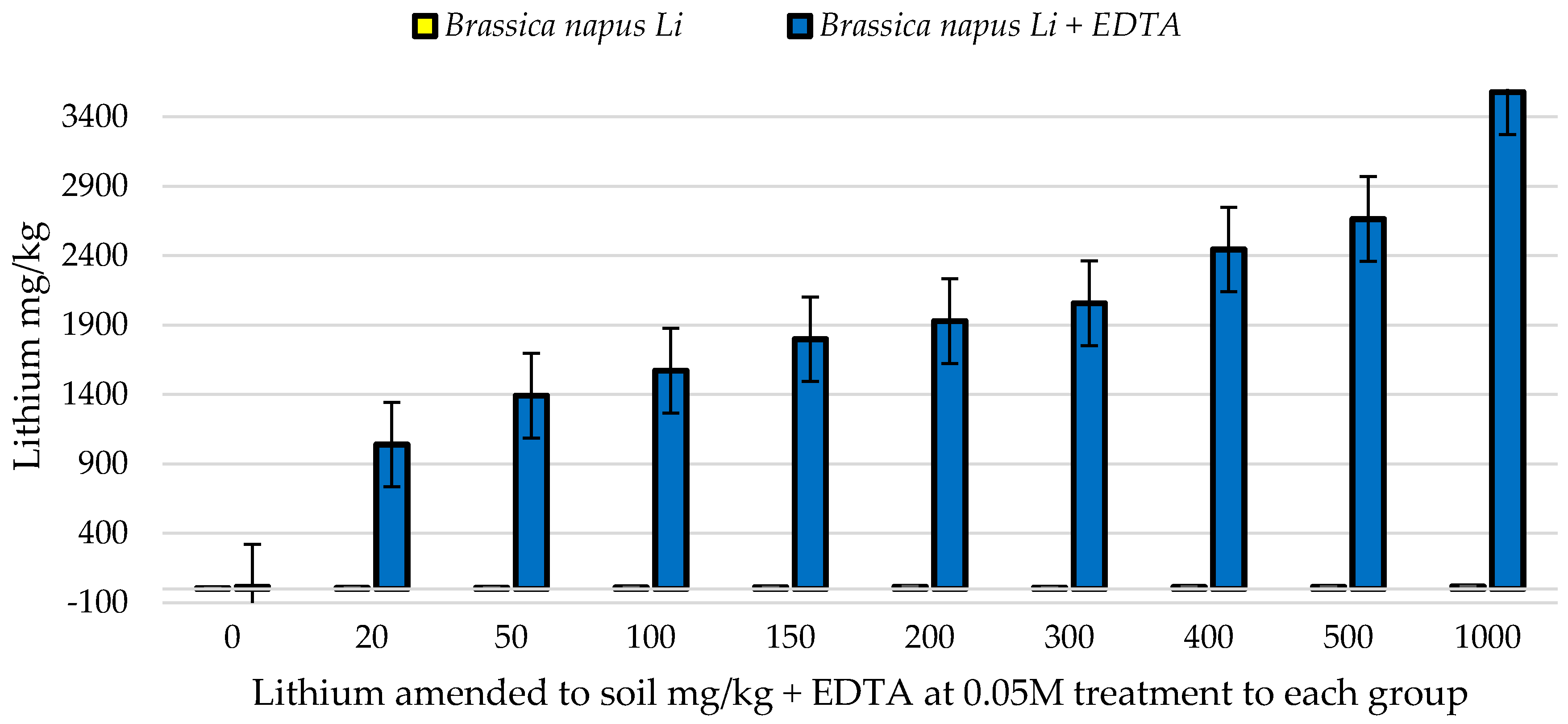
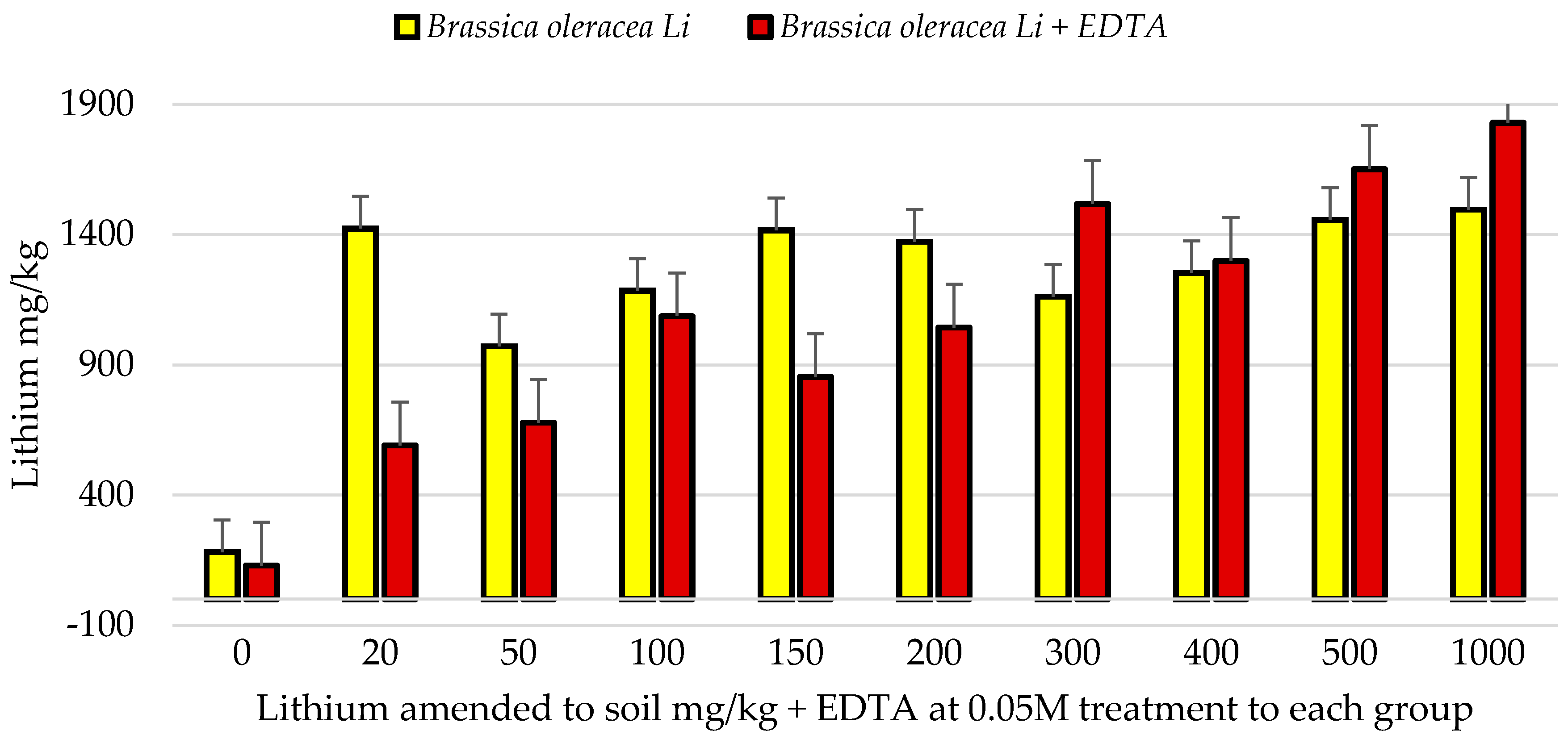
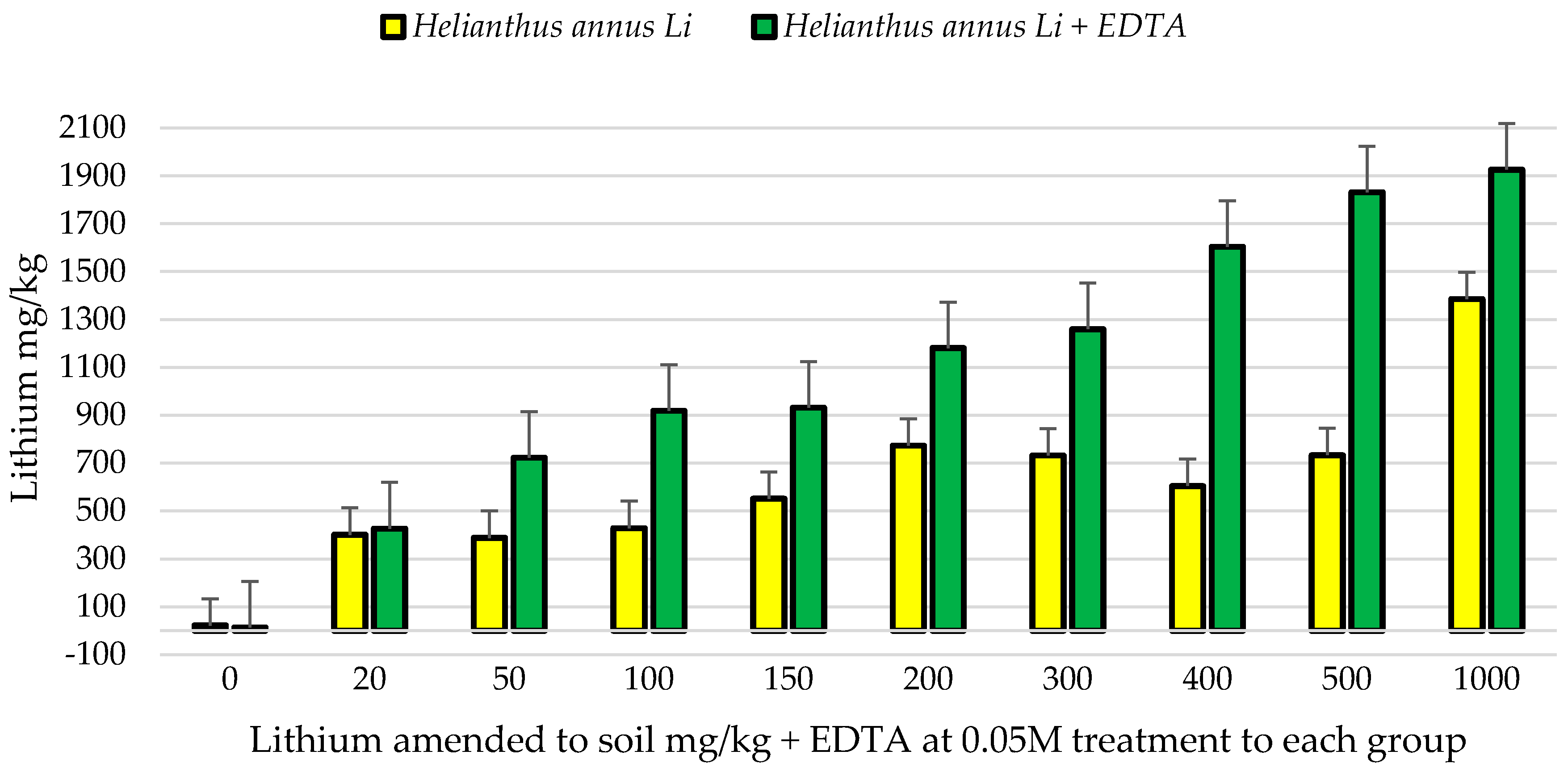
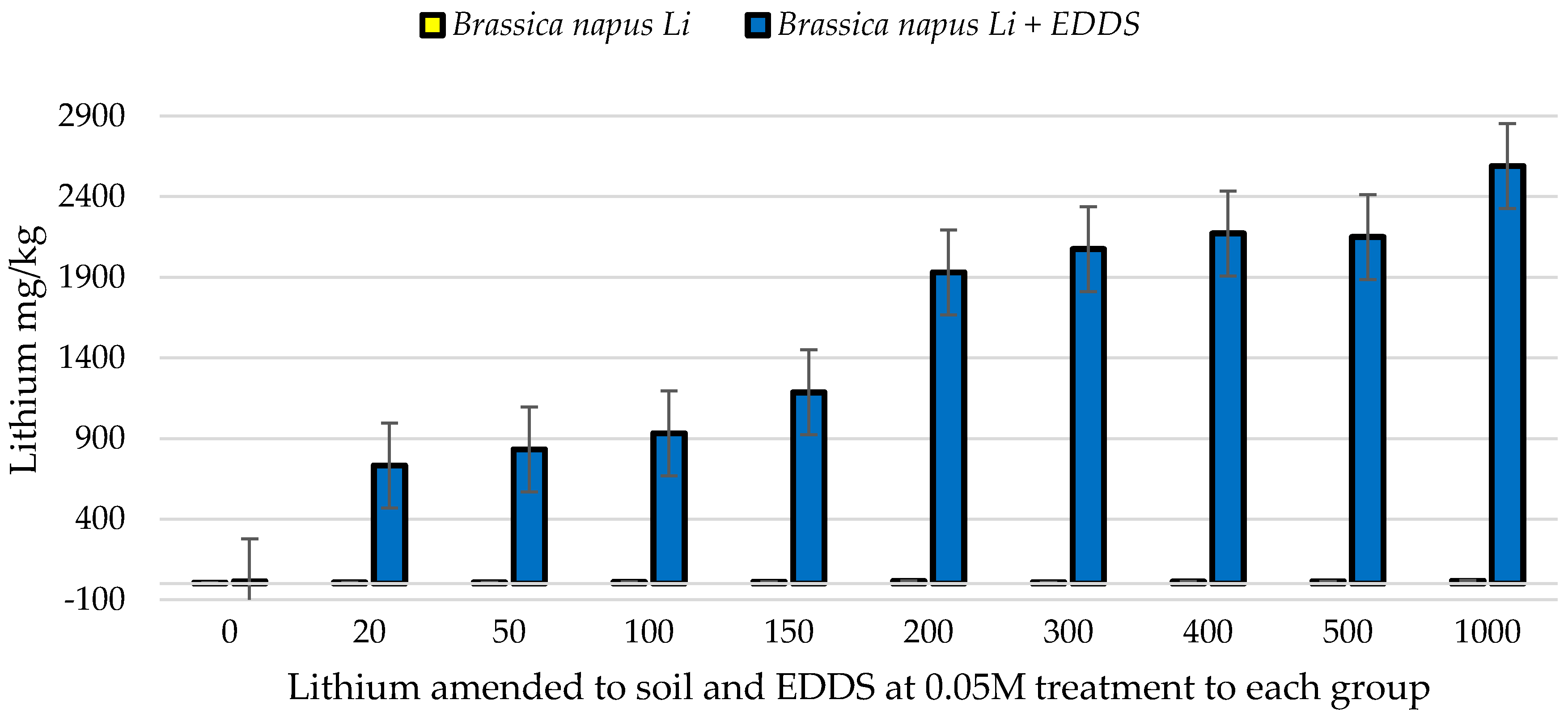
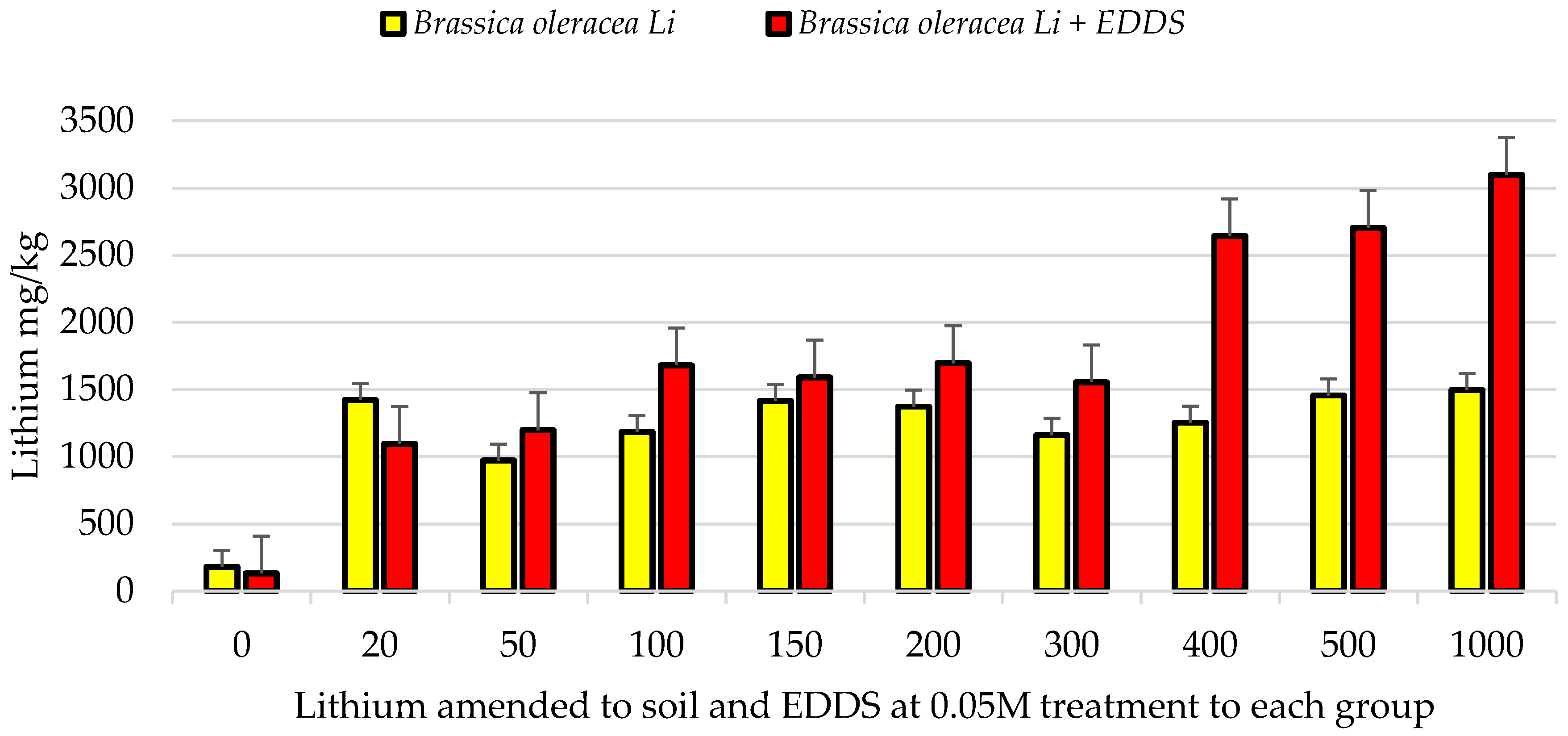
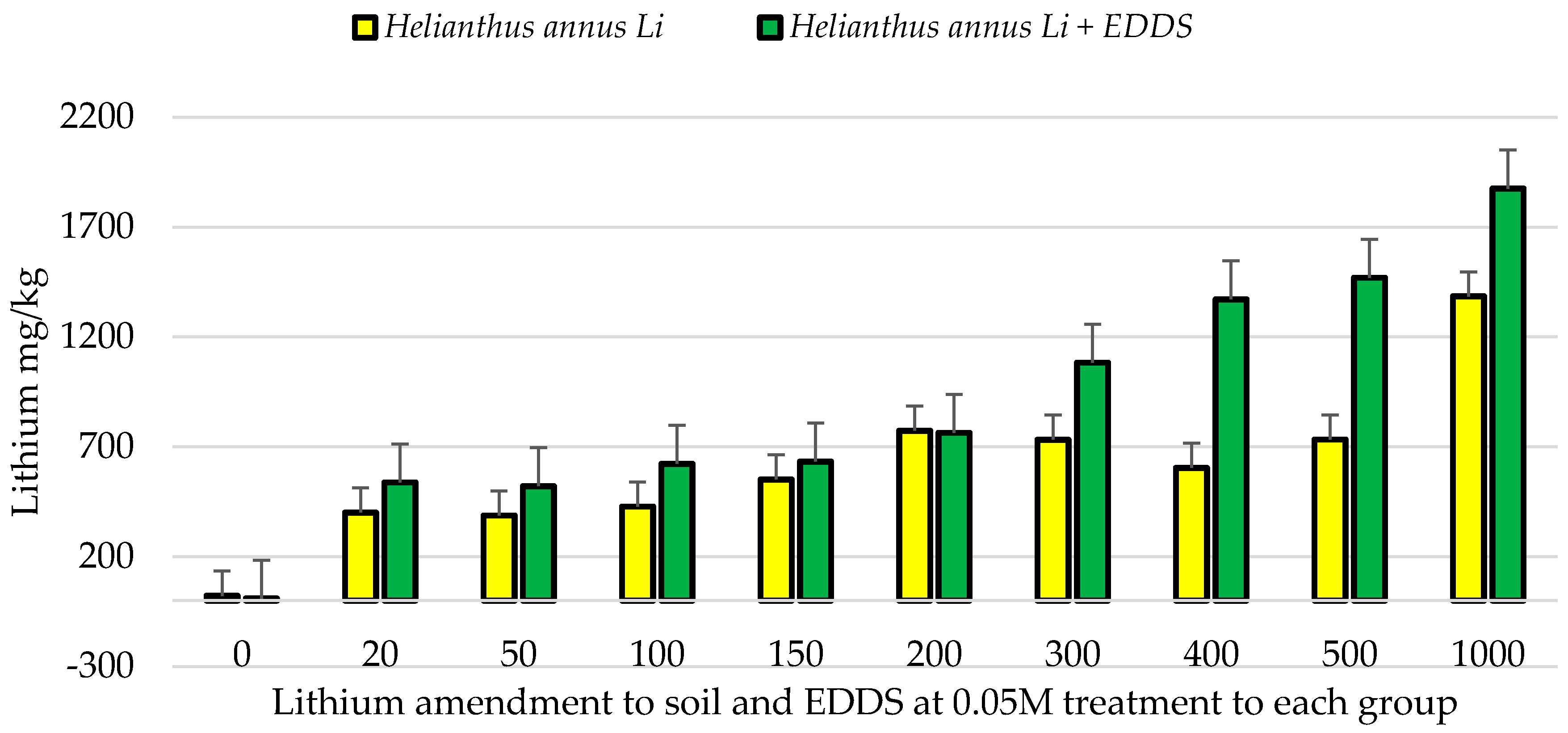
| Metal | Plant Species | (mg/kg) | References |
|---|---|---|---|
| As | Pteris vittata | 22,630 | [22] |
| Cd | Thlaspi caerulescens | 14,000 | [13] |
| Co. | Haumaniastrum robertii | 10,200 | [23] |
| Cu | Aeolanthus biformifolius | 9000 | [24] |
| Mn | Macadamia neurophylla | 55,000 | [14] |
| Ni | Thlaspi caerulescens | 4700 | [13] |
| Pb | Brassica juncea | 15,000 | [25] |
| Se | Astragalus bisulcatus | 10,000 | [26] |
| Tl | Biscutella laevigate | 14,000 | [27] |
| U | Brassica juncea | 5000 | [28] |
| V | Brassica juncea | 10,111 | [29] |
| Zn | Arabis paniculate | 20,800 | [30] |
| Metal | Plant Species | (mg/kg) | References |
|---|---|---|---|
| Li | Beta vulgaris | 5500 | [74] |
| Li | Chloris gayana | 2400 | [74] |
| Li | Gossypium malvaceae | 1100 | [74] |
| Li | Hordeum vulgare | 1131 | [80] |
| Li | Gossypium hirsutum | 1947 | [80] |
| Li | Helianthus annuus | 3292 | [72] |
| Li | Hordeum vulgare | 2058 | [65] |
| Li | Gossypium hirsutum | 2385 | [65] |
| Li | Apocynum venetum | 1800 | [77] |
| Li | Brassica cartinata | 8000 | [75] |
| Li | Nasturtium officinale | 1216 | [70] |
| Li | Raphanus raphanistrum | 1008 | [71] |
| Li | Lycium barbarum | 1120 | [76] |
| Li | Juncus cooperi | 3000 | [76] |
| Li | Allenrolfea occidentalis | 3000 | [76] |
| Li | Distichlis spicate | 1000 | [76] |
| Plant Species | Con | 20 | 50 | 100 | 150 | 200 | 300 | 400 | 500 | 1000 |
|---|---|---|---|---|---|---|---|---|---|---|
| Brassica napus | 6.2 | 7.8 | 7.7 | 10.5 | 11.6 | 15.9 | 8.5 | 13.6 | 14.1 | 17.5 |
| dry yield | 5.6 | 7.6 | 8.5 | 7.5 | 12.5 | 12.8 | 10.2 | 11.2 | 11.5 | 11.7 |
| Brassica oleracea | 181 | 1423 | 971 | 1184 | 1416 | 1372 | 1161 | 1252 | 1456 | 1496 |
| dry yield | 27.9 | 31.9 | 31.7 | 26.1 | 20.1 | 20.4 | 20.9 | 14.9 | 16.1 | 11.9 |
| Helianthus annuus | 22 | 400 | 388 | 428 | 551 | 773 | 732 | 604 | 733 | 1385 |
| dry yield | 187.7 | 169.1 | 186.3 | 165.3 | 460.9 | 129.6 | 119.2 | 201.8 | 332 | 146.3 |
| Solanum lycopersicum | 2.1 | 11.3 | 16.9 | 21.3 | 28.9 | 31.8 | 32.6 | 35.2 | 29 | 64.5 |
| dry yield | 19.2 | 18.3 | 16.8 | 13.6 | 14.1 | 15.7 | 17.3 | 13.7 | 13.9 | 10.5 |
| Cardamine hirsuta | 27 | 819 | 1066 | 1229 | 1831 | 2216 | 3340 | 3500 | 3559 | 4221 |
| dry yield | 1.9 | 1.3 | 1.9 | 1.5 | 1.4 | 1.67 | 1.73 | 1.29 | .8 | 1 |
| Plant Species, Trial Number | Li Concentration | Standard Deviation | Max Li |
|---|---|---|---|
| Trial 1, Brassica napus and Li | 11.3 | 3.9 | 17.5 |
| Trial 2, Brassica napus Li and EDTA | 1849 | 914 | 3577 |
| Trial 3, Brassica napus Li and EDDS | 1461 | 301 | 2590 |
| Trial 1, Brassica oleracea and Li | 1496 | 691 | 1456 |
| Trial 2, Brassica oleracea Li and EDTA | 1830 | 625 | 1830 |
| Trial 3, Brassica oleracea Li and EDDS | 1739 | 878 | 3091 |
| Trial 1, Helianthus annuus and Li | 601 | 354 | 1875 |
| Trial 1, Helianthus annuus Li and EDTA | 1081 | 609 | 1926 |
| Trial 1, Helianthus annuus Li and EDDS | 889 | 554 | 773 |
| Metal | Plant Species | kg/ha | Reference |
|---|---|---|---|
| Au | Daucus carota | 1.4 | [7] |
| Co. | Berkheya coddii | 12.6 | [85] |
| Ni | Streptanthus polygaloids | 100 | [6] |
| Ni | Alyssum murale | 105 | [86] |
| Ni | Berkheya coddii | 100 | [14] |
| Ni | Streptanthus polygaloids | 100 | [3] |
| Ni | Berkheya coddii | 121 | [2] |
| Pb | Cannabis sativa | 26.3 | [52] |
| Tl | Iberis intermedia | 40 | [23] |
| Zn | Thlaspi caerulescens | 30.1 | [21] |
| Zn | Cardaminopsis halleri | 10.3 | [17] |
© 2018 by the authors. Licensee MDPI, Basel, Switzerland. This article is an open access article distributed under the terms and conditions of the Creative Commons Attribution (CC BY) license (http://creativecommons.org/licenses/by/4.0/).
Share and Cite
Kavanagh, L.; Keohane, J.; Cabellos, G.G.; Lloyd, A.; Cleary, J. Induced Plant Accumulation of Lithium. Geosciences 2018, 8, 56. https://doi.org/10.3390/geosciences8020056
Kavanagh L, Keohane J, Cabellos GG, Lloyd A, Cleary J. Induced Plant Accumulation of Lithium. Geosciences. 2018; 8(2):56. https://doi.org/10.3390/geosciences8020056
Chicago/Turabian StyleKavanagh, Laurence, Jerome Keohane, Guiomar Garcia Cabellos, Andrew Lloyd, and John Cleary. 2018. "Induced Plant Accumulation of Lithium" Geosciences 8, no. 2: 56. https://doi.org/10.3390/geosciences8020056
APA StyleKavanagh, L., Keohane, J., Cabellos, G. G., Lloyd, A., & Cleary, J. (2018). Induced Plant Accumulation of Lithium. Geosciences, 8(2), 56. https://doi.org/10.3390/geosciences8020056





